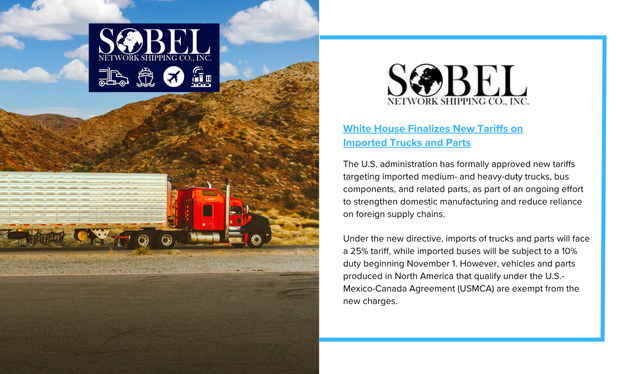The U.S. administration has formally approved new tariffs targeting imported medium- and heavy-duty trucks, bus components, and related parts, as part of an ongoing effort to strengthen domestic manufacturing and reduce reliance on foreign supply chains.
Under the new directive, imports of trucks and parts will face a 25% tariff, while imported buses will be subject to a 10% duty beginning November 1. However, vehicles and parts produced in North America that qualify under the U.S.-Mexico-Canada Agreement (USMCA) are exempt from the new charges.
In addition to the truck and bus levies, the administration announced the continuation of a tariff offset program for automakers that produce and sell vehicles in the United States. This initiative, extended through 2030, provides eligible manufacturers with partial relief from tariffs on imported components. The offset, worth up to 3.75% of the value of qualifying American-made vehicles, is intended to help companies absorb higher costs as they localize their supply chains.
A similar offset program is being developed for U.S.-based manufacturers of engines for passenger vehicles and commercial trucks, though it is not expected to take effect immediately.
Balancing Industry Impact and Domestic Goals
The new measures underscore the administration’s broader trade strategy — to encourage domestic production while recalibrating global trade relationships. However, they also highlight the delicate balance between protectionist policy and the realities of globalized manufacturing.
Industry groups have expressed concern that sweeping tariffs on imported parts and finished vehicles could drive up production costs and, in turn, raise prices for consumers and businesses dependent on commercial vehicles. Analysts caution that sectors such as construction, freight, and logistics may face higher equipment expenses as a result.
Extended Tariff Relief Period
Initially expected to phase out after two years, the tariff offset program will now continue for an additional five years, offering extended stability for U.S. automakers and suppliers. The move is viewed as part of a broader strategy to give domestic producers more time to realign sourcing and investment decisions before tariffs take full effect.
The new truck and parts tariffs join a widening list of duties applied to materials and goods — including metals, consumer electronics, and lumber — under Section 232 of the Trade Expansion Act, which authorizes import restrictions on national security grounds.
Trade and policy observers note that the measures are likely to face scrutiny in upcoming court reviews, as legal challenges to previous tariff actions continue to work their way through the judicial system.
As the new policies take effect, industry participants will be watching closely to assess their long-term impact on supply chains, pricing, and competitiveness across the transportation and manufacturing sectors.


